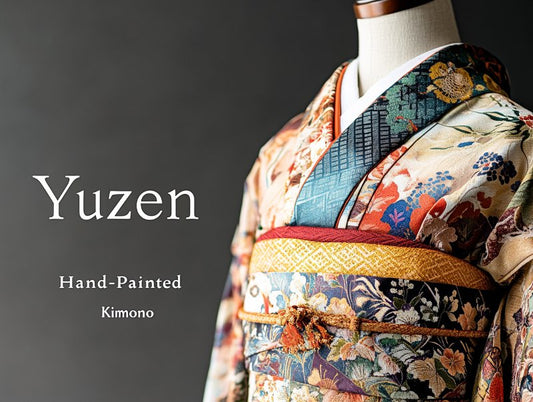
Reviving Tradition: Crafting Pants from Vintage Kimonos
Share
In a world where fashion trends come and go, there's a certain allure in the enduring elegance of the kimono. This iconic Japanese garment has been a symbol of culture, tradition, and artistry for centuries. While the kimono has a rich history, it is not immune to the changing times. As we look to celebrate the past and embrace the present, we've embarked on a journey to transform vintage kimonos into something fresh, contemporary, and utterly unique: pants.
The Journey Begins: Sourcing Vintage Kimonos

We are always looking for beautiful kimonos to be brought back to life.
Our quest to create kimono pants starts with the careful selection of vintage kimonos. Each kimono is more than just a piece of fabric; it's a piece of history. These garments have graced the shoulders of generations, carrying with them the stories of their wearers and the skill of their creators.
We source our vintage kimonos from various regions of Japan, carefully examining each one for its quality, uniqueness, and historical significance. Some kimonos have intricate hand-painted designs, while others boast exquisite embroidery or weaving. Every kimono we select is a work of art in its own right, and we're committed to preserving its essence.
The Art of Deconstruction: Unraveling the Kimono
Once we've chosen the perfect vintage kimono, the delicate process of deconstruction begins. It's a task that requires a gentle touch and a deep respect for the craftsmanship that went into creating the original garment.

Our skilled artisans carefully disassemble the kimono, piece by piece, preserving every inch of its precious fabric. Nothing is wasted; even the smallest scraps are saved for future use. This commitment to minimizing waste is not only eco-conscious but also a tribute to the resourcefulness of Japanese craftsmanship.
Craftsmanship Meets Creativity: Transforming Kimono Fabric into Pants
With the kimono fabric in hand, we turn to master tailors and designers to bring our vision to life. The transformation from a traditional kimono into a pair of modern pants is a creative process that marries the old with the new.

The design stage is a true fusion of creativity and respect for the fabric's history. Our designers carefully consider the unique patterns, colors, and textures of the kimono fabric, ensuring that they are accentuated in the final pants. Whether it's wide-legged trousers, slim-fit slacks, or flowing wrap pants, each pair of pants is a testament to the versatility of kimono fabric.
A Piece of Japanese Heritage: Wearing Kimono Pants
When you slip into a pair of kimono pants from Kimono Koi, you're not just donning a stylish garment; you're embracing a piece of Japanese heritage. Each pair of pants carries with it the stories and traditions of the vintage kimono from which it was born.
The beauty of kimono pants lies in their ability to effortlessly blend tradition with modernity. They can be dressed up for a formal occasion or paired with a casual top for a chic everyday look. Whether you're strolling through the bustling streets of Tokyo or attending an elegant soirée, kimono pants are a symbol of timeless elegance.
Conclusion: The Art of Transformation
In the heart of Japan, where tradition meets innovation, the art of crafting pants from vintage kimonos comes alive. This unique journey, from sourcing exquisite kimonos to carefully deconstructing and redesigning them into contemporary pants, is a testament to our commitment to preserving Japan's cultural heritage.
At Kimono Koi, we celebrate the beauty of tradition and the endless possibilities of creativity. With each pair of kimono pants, we pay homage to the past while embracing the present, offering you a piece of Japanese history that's as stylish as it is meaningful.


